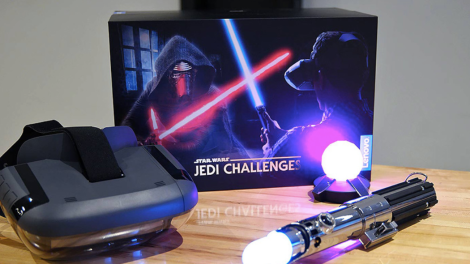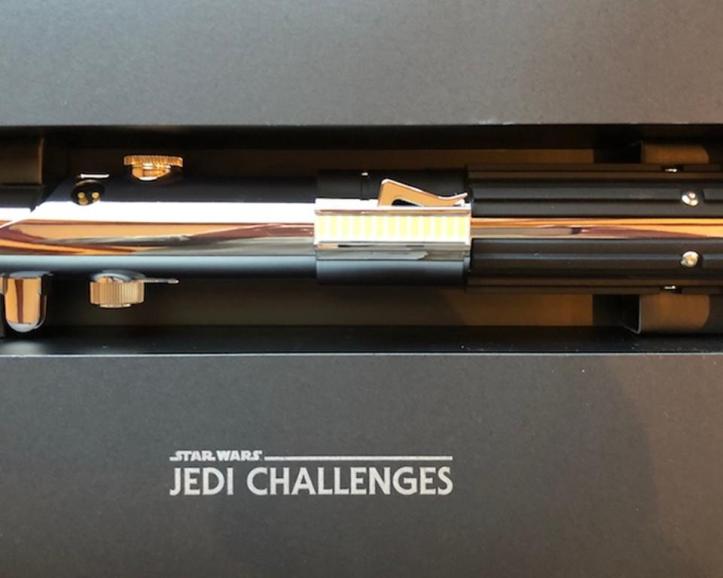I got the chance to play with the Jedi Challenges AR Lightsaber by Disney and boy was it addictive. It costs about $200, and was released ahead of the newest Star Wars saga film, The Last Jedi, which is out this week. It is one of the hottest Star Wars toys for the holidays. But before I delve into that, let’s look at this intrigue by people the world over on a little stick that supposedly emits a laser powerful enough to cut through almost anything.
Part of the fascination with the lightsaber stems from its blend of history, science, and fantasy. With a hilt and a blade, Star Wars creator George Lucas harkened back to legendary weapons of old, like King Arthur’s sword. The blade being made of light adds an element of technology to it. Yet it defies the laws of physics. Light cannot extend three feet and stop without anything to reflect the light back. And light generally does not interact with light the way that two lightsabers do in battle. It’s magic, or rather, the Force, that enables it.
It’s been recreated in countless toys over the past 40 years, from the original 1978 model by now-defunct toymaker Kenner, which was basically a flashlight with an inflatable vinyl blade affixed to it, to modern replicas from companies like Hasbro with blades lit by LED lights and motion-sensing sound effects that can run for as much as $200. There are cheaper models, too. You can build your own lightsaber in some Disney parks. The weapon is featured in Star Wars video games like Star Wars: Battlefront. And it’s a pivotal part of experiences like the “Trials of Tatooine” virtual-reality demo from Lucasfilm’s ILMxLAB.
There are unofficial iterations as well. Custom sabers that are durable enough for combat and have tailored lights and sound effects start at $55 and climb to more than $500 from companies like UltraSabers. A fan recently built an AR app that turns rolled-up pieces of paper into lightsabers. And there are those lightsaber classes, like Mermelstein-Knox took, in places like New York and San Francisco. Some of the earliest lightsaber toys hummed or whistled in imitation of it when you swung them.
So the guys at Disney set to work. All the challenges of building a lightsaber today, for the sophisticated kids who would pick them up, were compounded by the fact that Disney had to create something with a price point that would woo the average fanboy or girl to splurge, and overindulgent parents to buy for their children. They settled at around $200.
The team had to make some trade offs to make that work. For example, the current version does not support multiple players, which is something Disney is still working on. But they also had to work on the things that fans really cared about—such as the sound. The team did extensive research on the sounds lightsabers make when they’re swung for an earlier, never-released lightsaber product for Disney, which was audio only. They used that, and the lightsaber audio directly from the movies, from Lucasfilm, to create the sounds heard in the game. There’s a unique buzz for each way the lightsaber moves. And it’s three-dimensional, so if you’re wearing headphones while using the device, the humming sounds as if it’s coming from the part of the room that it’s meant to be in.
And then there is the blade—one of the hardest aspects of the lightsaber to recreate because there’s nothing like it that exists in real life. It’s also the most crucial. The blade of the 1978 toy lightsaber was made of inflatable vinyl that deflated when swung too hard. It came with a patch kit for the inevitable repairs. Later models were made of plastic tubes, some of which extended out. In the 2000s, toymakers like Master Replicas began incorporating LED lights into the plastic blades to make them brighter. But the LEDs would pop if they hit hard enough against another lightsaber and leave gaps in the light. They weren’t ideal for combat.
Companies like UltraSabers, which does not make official Star Wars replicas, eventually started using polycarbonate, a very strong plastic, which was safer to duel with. The polycarbonate that UltraSabers uses can withstand over 50 pounds, a spokesperson told Quartz. Its hilts are made of aircraft-grade aluminum. Still, it can’t quite capture the experience of wielding a weapon truly made of light, like in the films.

Jedi Challenges, the AR game, relies on an LED light placed at the end of the physical hilt to tell the virtual blade where it needs to go. It’s aided by a sensor inside the hilt—with an accelerometer, gyroscope, and magnetometer—that helps with orientation and motion, and cameras and sensors inside the headset. Tracking the blade as the wielder moves was the hardest part. It took about two years and 70 prototypes to get right. The external tracking device marks of the place space for the game.
Since you’re (hopefully) not hitting anything tangible when playing, the hilt is outfitted with a haptic motor that vibrates when it turns on, and when it makes contact with something in augmented reality. That’s how you know if you’ve hit something. The motor also speeds up and slows down based on how the device moves.

The AR one was modeled after Luke’s first weapon, which was crafted by his father, Anakin, and later found its way into Rey’s hands. Disney consulted with Lucasfilm, which makes sure all physical Star Wars products are authentic to how they look on screen. Devotees may know that the design used in The Force Awakens was slightly different from that in the earlier movies. The AR game is true to the 2015 movie.
Disney is also hoping to take the technology beyond the living room. Disney’s consumer products and interactive division, which made the game, is in talks with its theme-park arm to bring the augmented-reality experience into Disney parks. The company has been experimenting with new ways to incorporate the lightsaber into its parks as it develops new Star Wars-themed lands, which are set to open in 2019, and Star Wars-themed hotels. Disney Research filed a patent application last year that detailed a system of drones, laser beams, and other devices that could simulate a lightsaber experience.
So try it out if you can and awaken your inner Jedi. Just make sure that you are playing with it in a safe environment around people that you are comfortable with because it does look kind of funny watching someone weld a plastic toy around wildly. But for the player, it brings on a new dimension of realty. Thoroughly enjoyable. May the force be with you.
Interesting reads:
https://www.digitaltrends.com/cell-phone-reviews/star-wars-jedi-challenges-review/
http://variety.com/2017/digital/news/star-wars-jedi-challenges-ar-headset-1202606445/
https://flipboard.com/@flipboard/-bringing-the-lightsaber-from-star-warst/f-c49356edf3%2Fqz.com
https://gizmodo.com/the-new-star-wars-ar-game-is-clunky-cool-still-too-ex-1820092627
I’m not a Star Wars fan but this looks amazing even to me, how awesome!!
LikeLiked by 1 person
Yes! These guys really went through a good design process that produced a product that is pretty good. Even if you are not a fan, try to get your hands on one to try it out!
LikeLike
LikeLiked by 1 person
A happy new year to you too!
LikeLiked by 1 person
I saw [the ‘original’] Star Wars in the laser-disc era, and Aye!, watching Jedis wielding blue/red light was quite sensational 🙂
LikeLiked by 1 person
Wielding that lightsaber brings so much mystique and memories!
LikeLike